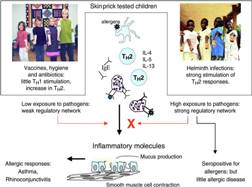Expression cloning of immunomodulatory glycan-modifying enzymes in insect cells
SUPERVISOR: IAIN WILSON
Project assigned to: SIMONE KURZ
Background.
The differences in glycosylation between insects, nematodes, prokaryotes and mammals present challenges in terms of their immunogenicity and the understanding of the molecular basis of their production. At the same time, non-mammalian systems are also a potentially useful resource in terms of altered glycoprotein properties, e.g. in terms of the immunomodulatory potential of their glycans. Particularly, nematode glycans are associated with the dampening of immune responses and may be potential therapeutics for inflammatory diseases (for a review about nematode glycans, see Paschinger et al., 2008). However, the genetic and enzymological basis for some of these modifications is unknown; on the other hand, some of these glycan modifications can be recognised by lectins or antibodies, which can facilitate the identification of the requisite genes. Furthermore, the currently-used forms of immunomodulatory glycoproteins (e.g. ES-62 from Acanthocheilonema viteae) are isolated from native sources, and recombinant forms do not have the same activity; therefore, for large-scale production a recombinant form with the correct modification is required.

Aims and methods.
In the proposed work, insect cells would be used as a workhorse for expression-based cloning of relevant cDNAs which confer altered glyco-epitopes to these cells; in particular, phosphorylcholinyltransferases from nematodes represent a biologically significant target, since these would then be useful in preparing proteins with potentially immunomodulatory activity. Previous studies in my group on cloning invertebrate glycosyltransferases have been based on identifying genes by homology; however, for some glycan modifications such as glycan-bound phosphorylcholine, no enzyme is known for their biosynthesis and, thus, an alternative cloning approach is required. Such expression-cloning approaches have been already successfully used in mammalian cells, but - as these do not express the truncated N-glycans generally found in invertebrates - it is doubtful that they can be efficiently used for our purpose. On the other hand, insect cells should contain many of the enzymes and transporters required for the nucleotide donor metabolism necessary for generation of substrates for invertebrate glyco-modifications.
Initial efforts would be directed at the use of a Gateway Caenorhabditis elegans library, which would be recombined in vitro into an insect cell expression system/baculovirus expression system; transfected Sf9 cells will then be selected by fluorescence-activated cell sorting using relevant antibodies or lectins. Baculoviruses from epitope-enriched populations will then be isolated, and the next round of infection and selection will be performed with the goal of isolating single clones encoding the relevant enzyme. In the case of phosphorylcholine, a monoclonal antibody is available and this will be used to ‘fish out’ populations of cells with surface glycan-bound phosphorylcholine. Once a single clone is isolated, the DNA sequence will be determined and a form of the enzyme for soluble expression prepared; this form would then be subject to in vitro HPLC or MS-based tests as to its enzymatic properties. Finally, full length forms (with the relevant intracellular targetting signals) will be used in co-expression experiments in order to produce relevantly-modified forms of recombinant proteins (such as the aforementioned immunomodulatory ES-62 protein); the modifications of these would then be analysed to verify whether the desired form has been produced.
Paschinger, K., Gutternigg, M., Rendic, D., Wilson, I. B. H. (2008) The N-glycosylation pattern of Caenorhabditis elegans. Carbohydr. Res. 343, 2041-2049
